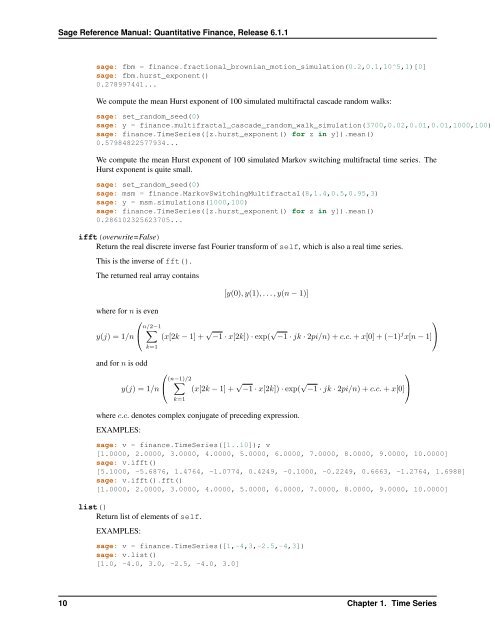Sage Reference Manual: Quantitative Finance - Mirrors
Sage Reference Manual: Quantitative Finance - Mirrors
Sage Reference Manual: Quantitative Finance - Mirrors
You also want an ePaper? Increase the reach of your titles
YUMPU automatically turns print PDFs into web optimized ePapers that Google loves.
<strong>Sage</strong> <strong>Reference</strong> <strong>Manual</strong>: <strong>Quantitative</strong> <strong>Finance</strong>, Release 6.1.1<br />
sage: fbm = finance.fractional_brownian_motion_simulation(0.2,0.1,10^5,1)[0]<br />
sage: fbm.hurst_exponent()<br />
0.278997441...<br />
We compute the mean Hurst exponent of 100 simulated multifractal cascade random walks:<br />
sage: set_random_seed(0)<br />
sage: y = finance.multifractal_cascade_random_walk_simulation(3700,0.02,0.01,0.01,1000,100)<br />
sage: finance.TimeSeries([z.hurst_exponent() for z in y]).mean()<br />
0.57984822577934...<br />
We compute the mean Hurst exponent of 100 simulated Markov switching multifractal time series. The<br />
Hurst exponent is quite small.<br />
sage: set_random_seed(0)<br />
sage: msm = finance.MarkovSwitchingMultifractal(8,1.4,0.5,0.95,3)<br />
sage: y = msm.simulations(1000,100)<br />
sage: finance.TimeSeries([z.hurst_exponent() for z in y]).mean()<br />
0.286102325623705...<br />
ifft(overwrite=False)<br />
Return the real discrete inverse fast Fourier transform of self, which is also a real time series.<br />
This is the inverse of fft().<br />
The returned real array contains<br />
[y(0), y(1), . . . , y(n − 1)]<br />
where for n is even<br />
⎛<br />
⎞<br />
n/2−1<br />
∑<br />
y(j) = 1/n ⎝ (x[2k − 1] + √ −1 · x[2k]) · exp( √ −1 · jk · 2pi/n) + c.c. + x[0] + (−1) j x[n − 1] ⎠<br />
and for n is odd<br />
k=1<br />
⎛<br />
y(j) = 1/n ⎝<br />
(n−1)/2<br />
∑<br />
k=1<br />
(x[2k − 1] + √ −1 · x[2k]) · exp( √ −1 · jk · 2pi/n) + c.c. + x[0] ⎠<br />
where c.c. denotes complex conjugate of preceding expression.<br />
EXAMPLES:<br />
sage: v = finance.TimeSeries([1..10]); v<br />
[1.0000, 2.0000, 3.0000, 4.0000, 5.0000, 6.0000, 7.0000, 8.0000, 9.0000, 10.0000]<br />
sage: v.ifft()<br />
[5.1000, -5.6876, 1.4764, -1.0774, 0.4249, -0.1000, -0.2249, 0.6663, -1.2764, 1.6988]<br />
sage: v.ifft().fft()<br />
[1.0000, 2.0000, 3.0000, 4.0000, 5.0000, 6.0000, 7.0000, 8.0000, 9.0000, 10.0000]<br />
list()<br />
Return list of elements of self.<br />
EXAMPLES:<br />
sage: v = finance.TimeSeries([1,-4,3,-2.5,-4,3])<br />
sage: v.list()<br />
[1.0, -4.0, 3.0, -2.5, -4.0, 3.0]<br />
⎞<br />
10 Chapter 1. Time Series

















